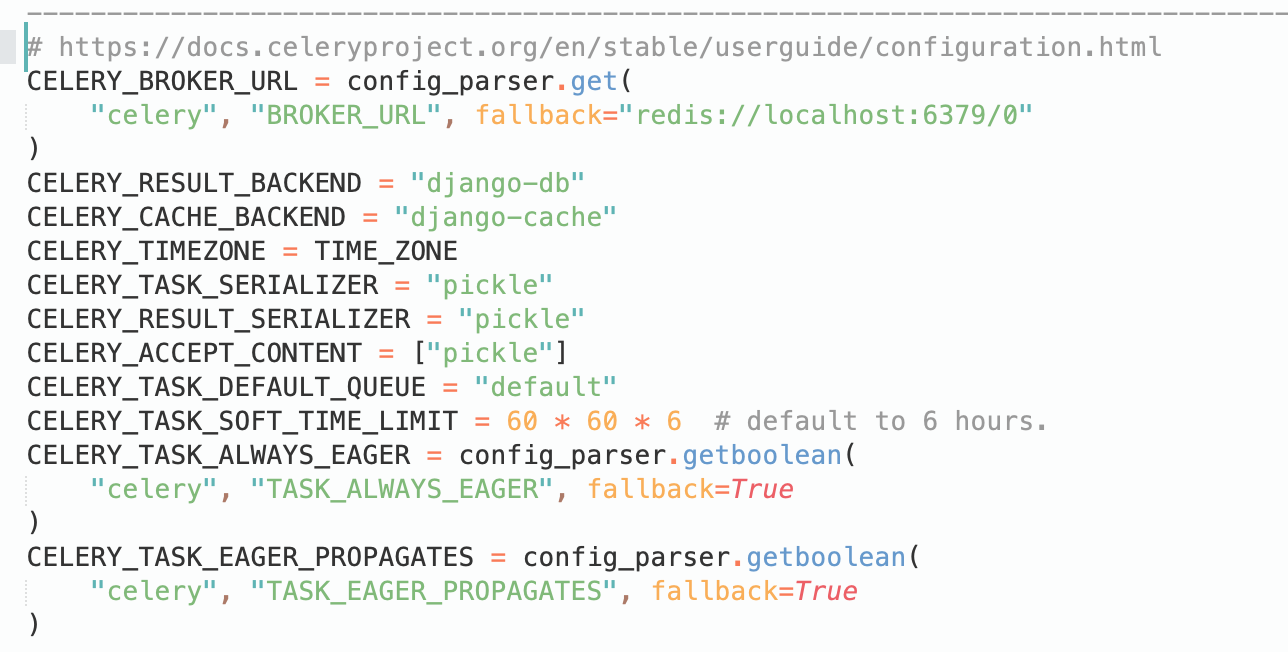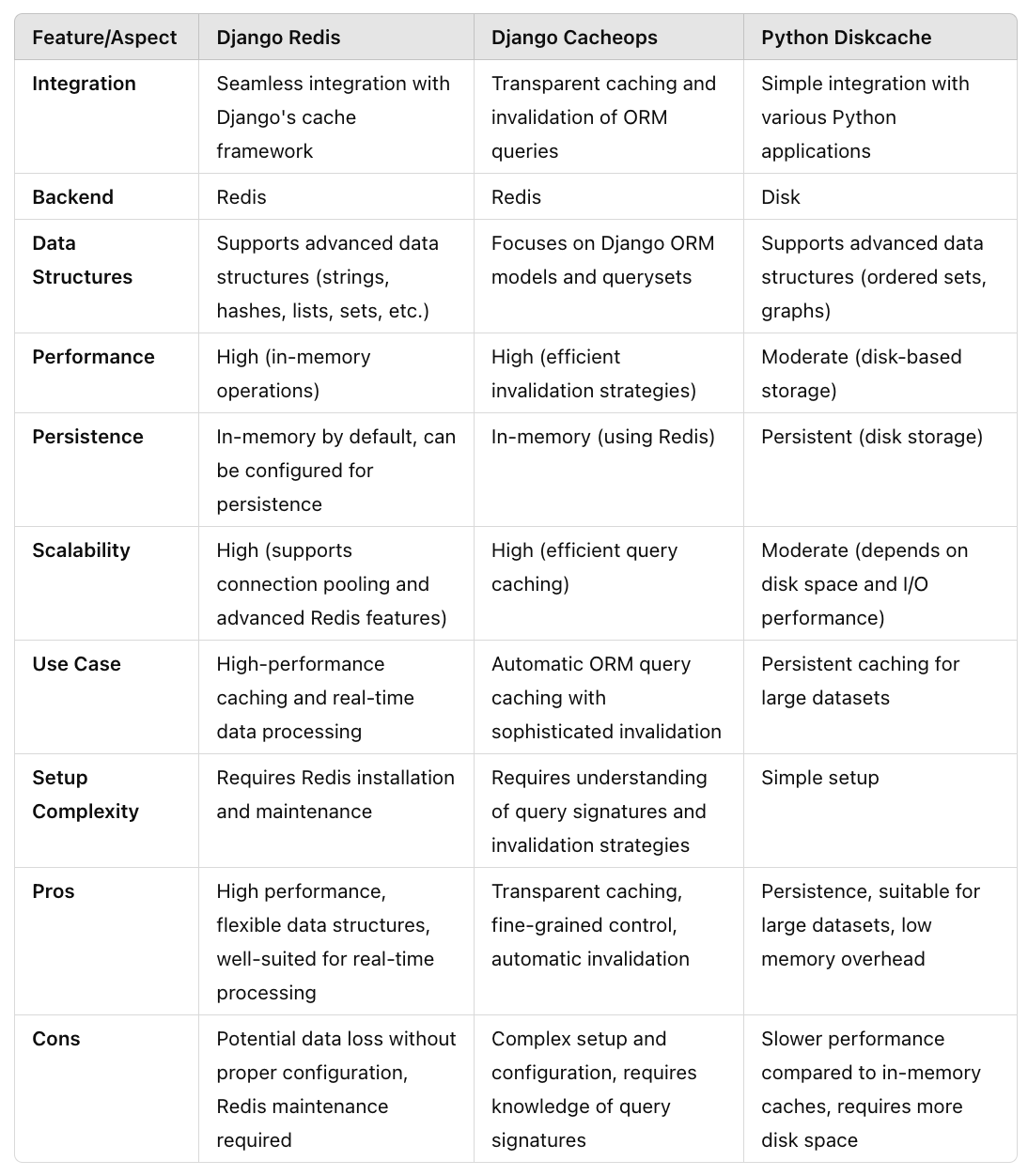[One Package Per Day] Django Redis
By hientd, at: June 5, 2024, 3:38 p.m.
Estimated Reading Time: __READING_TIME__ minutes
![[One Package Per Day] Django Redis](/media/filer_public_thumbnails/filer_public/13/6d/136d5c23-ac5c-4764-86be-3715c7120a74/django-redis.png__1500x900_q85_crop_subsampling-2_upscale.jpg)
![[One Package Per Day] Django Redis](/media/filer_public_thumbnails/filer_public/13/6d/136d5c23-ac5c-4764-86be-3715c7120a74/django-redis.png__400x240_q85_crop_subsampling-2_upscale.jpg)
The Glinteco has been working with Redis and Django for years and we believe there is a need for a detail blog post for those topics.
Luckily, Django Redis is a robust library that integrates Redis with Django, providing a highly efficient way to cache your data and enhance your web application's performance. Django Redis, developed by the Jazzband community, allows you to use Redis as a cache backend in your Django projects. Below is an overview of its features and some practical usage tips.
Django Redis is also a great tool for message queue management: CELERY_BROKER_REDIS_URL="redis://localhost:6380"
Key Features
- Easy Integration: This package seamlessly integrates with Django’s cache framework, allowing you to quickly set up and use Redis as your caching backend.
- High Performance: Utilizing Redis, a powerful in-memory data structure store, Django Redis can significantly enhance your application's speed and responsiveness, offering superior performance even compared to the native Django cache support.
- Support for Advanced Data Structures: Redis supports a variety of data structures such as strings, hashes, lists, sets, and sorted sets, enabling more complex caching strategies.
- Connection Pooling: Django Redis supports connection pooling, reducing the overhead of establishing new connections and ensuring efficient resource usage.
- Built-in Commands: The library provides access to Redis commands directly from Django, allowing you to leverage Redis’s full capabilities within your Django project.
- Session Management: Django Redis can be used to store session data, providing a fast and scalable solution for session management.
Setting Up Django Redis
Step 1: Install Redis and Django Redis
First, you need to have Redis installed on your system. You can download and install it from the official Redis website.
Next, install the Django Redis package via pip:
pip install django-redis Step 2: Configure Django Settings
Add the following configuration to your settings.py file to set up Django Redis as your cache backend:
CACHES = {
"default": {
"BACKEND": "django_redis.cache.RedisCache",
"LOCATION": "redis://127.0.0.1:6379/1",
"OPTIONS": {
"CLIENT_CLASS": "django_redis.client.DefaultClient",
}
}
}Step 3: Use Caching in Your Views
You can now use Django’s cache framework to cache data in your views. Here’s an example:
from django.core.cache import cache
from django.shortcuts import render
def call_daddy(request):
call_daddy = cache.get('user_call_daddy')
if not call_daddy:
call_daddy = 1
cache.set('user_call_daddy', call_daddy, timeout=60*15) # Cache for 15 minutes
else:
call_daddy = int(call_daddy)
cache.set('user_call_daddy', call_daddy + 1, timeout=60*15) # Cache for 15 minutes
return render(request, 'my_template.html', {'call_daddy': call_daddy})
Common Use Cases
- Caching Expensive Queries: By caching results of expensive database queries, you can reduce the load on your database and speed up response times.
- Caching Frequent Calculated Value: Calculated value is costly, you can reduce the load on your CPU and save task execution time.
- Session Storage: Storing session data in Redis can improve the performance and scalability of your session management.
- Rate Limiting: Use Redis to implement rate limiting to protect your application from abuse by limiting the number of requests a user can make in a given time period.
- Task Queues: Integrate with task queues like Celery to handle background tasks efficiently.

Challenges and Considerations
While Django Redis is a powerful tool, there are a few challenges and considerations to keep in mind:
- Persistence: By default, Redis stores data in-memory, which means data will be lost if Redis is restarted. To ensure persistence, you need to configure Redis to save snapshots to disk.
- Memory Management: Redis operates in-memory, so it’s crucial to monitor memory usage and configure eviction policies to prevent memory overflow.
- Security: Ensure that your Redis instance is secured, especially if it’s accessible over a network. Use authentication and configure Redis to listen on a private network or localhost.
Compare Django Redis vs Django Cacheops vs Python Diskcache

Performance Metrics - Small Test Case Scenario
Benchmarks: Comparing Response Times with and without Django Redis on requesting a list API
Benchmark tools: Locust Python
Restful APIs: Django Rest Framework
To understand the impact of Django Redis on your application's performance, we conducted several benchmarks comparing response times with and without caching. The tests involved a typical Django restful application performing database queries and returning JSON. Here are the results:
Test Scenario:
- Without Caching: The API fetches data from the database and return JSON data for each request.
- With Django Redis Caching: The application first checks the cache for data. If the data is not present, it fetches it from the database, caches it, and then renders the template.
Benchmark Results:

Conclusion
Django Redis is a valuable addition to any Django project that requires efficient caching and session management. By leveraging Redis’s powerful in-memory data structures, Django Redis can significantly boost your application’s performance and scalability. As with any tool, it’s important to understand its strengths and limitations to make the most out of its capabilities.
Stay tuned for our next post in the "One Day One Package in Django" series, where we’ll explore another essential Django package to enhance your development workflow!

![[One Package Per Day] - Django Reversion](/media/filer_public_thumbnails/filer_public/62/b1/62b10ec6-5dad-44f1-9f73-77f4e601a386/django-reversion.png__400x240_q85_crop_subsampling-2_upscale.jpg)
![[One Package Per Day] - Django Filter](/media/filer_public_thumbnails/filer_public/d8/4d/d84da711-ddbf-48e9-98bc-52d251129253/one_package_per_day_-_django_filter.png__400x240_crop_subsampling-2_upscale.png)
![[One Day One Package] An Overview of Django Ninja](/media/filer_public_thumbnails/filer_public/cf/6f/cf6f4036-7f78-45c7-87bb-55901cc3b80f/django_ninja.png__400x240_q85_crop_subsampling-2_upscale.jpg)

